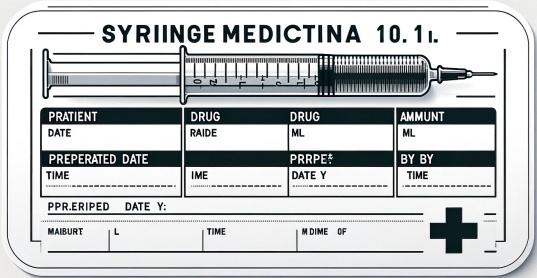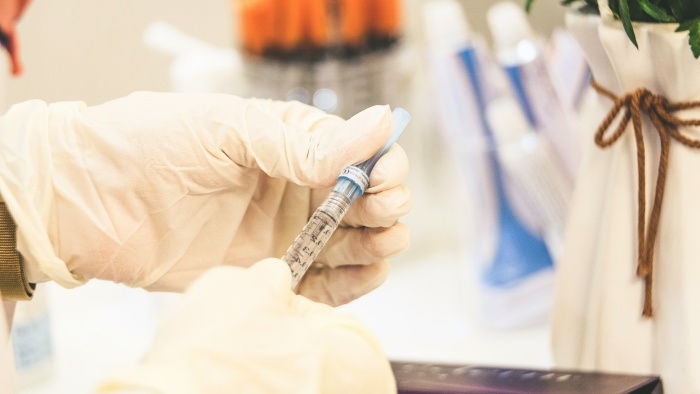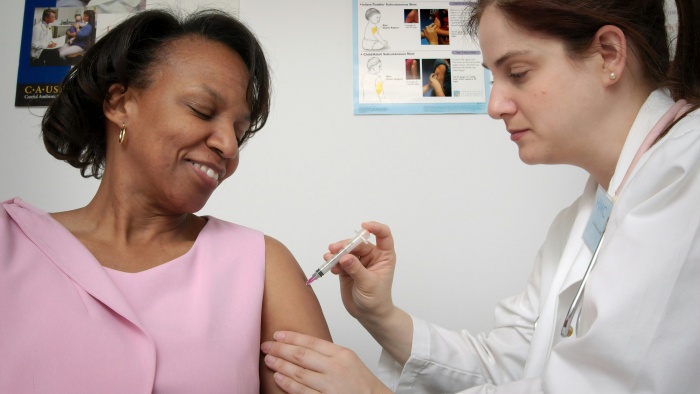Syringe labeling, whether it’s directly into a patient’s deltoid muscle or through an IV tubing port, represents a common method for administering medication. Utilizing syringes requires meticulous attention to detail to avoid errors that can have significant consequences.
The Agency For Healthcare Research And Quality highlights a concerning statistic: nearly 5% of hospitalized patients experience an Adverse Drug Event (ADE), making these one of the most common types of inpatient errors.
Such errors often stem from drug mix-ups. To confront these inevitable challenges, employing a detailed syringe labeling guide is crucial. This guide can significantly aid in reducing preventable errors and enhancing overall patient safety by ensuring clarity and accuracy in medication administration.
What are syringe labels?
A syringe label is an essential tool in the medical field, designed to include vital information about the medication and the patient. It serves as a crucial checkpoint for healthcare professionals, ensuring that the correct medication is administered to the right patient at the appropriate dose and time.
By providing clear, concise, and accurate details, syringe labels play a pivotal role in minimizing medication errors and significantly enhancing patient safety. These labels are fundamental to streamlining healthcare procedures and promoting consistency and reliability in patient care.
Syringe labeling standards
Proper labeling has been consistently shown to reduce medication errors across various healthcare settings, with its importance magnified in high-stress areas like the Emergency Department. Regardless of the setting, syringe use mandates adherence to compliance medicine labeling guidelines that stipulate the inclusion of the drug name and dosage/concentration on the label. The American Society of Anesthesiologists Headquarters (ASAHQ) further recommends incorporating additional details such as:

- Date and time of preparation,
- Initials or full name of the person administering the medication,
- The patient’s full name,
- Route of medication administration.
Moreover, integrating safety mechanisms such as the ASTM color coding system can further enhance medication safety. This system assigns specific colors to different drug classes, helping to prevent confusion and facilitate the correct dispensing of medications.
Additionally, innovative labeling solutions like wrap-around drug labels that utilize Tall Man lettering and Look Alike Sound Alike (LASA) indicators can alert healthcare professionals to potential medication confusion, thus safeguarding against the risks of similar drug names.
How can you effectively label a medical syringe?
Considering the diverse sizes of syringes utilized for medication administration, proper labeling encompasses a variety of challenges. While the term ‘syringe’ encompasses the entire assembly, including the barrel, plunger, and needle, the label itself is typically affixed to the barrel.
Syringe barrels can vary significantly, from as small as 0.25 ml to as large as 450 ml. Generally, the larger and longer the barrel, the simpler it is to apply a label, due to increased surface area. Conversely, a smaller barrel circumference not only makes label application more challenging but also increases the pressure required to dispense medication.
A crucial aspect of syringe labeling involves the selection of appropriate label materials. Given the often small diameter of syringe barrels, it is vital to choose a flexible material that can easily conform to the cylindrical shape.

This flexibility helps prevent the label from detaching or ‘flagging,’ which can obscure crucial medication information. The material should also be conducive to writing, allowing medical personnel to add necessary details using a pen or marker.
Once the correct materials are selected and the challenges of different barrel sizes are addressed, the actual labeling process can begin. A standard syringe label typically measures ½” in depth and 1 ½” in length. To maximize readability, it’s important to apply the label longitudinally along the barrel, ensuring that any dose graduations remain visible.
Finally, when placing the syringe on a tray or similar surface before use, it should be positioned with the label facing upwards, making it easily visible to healthcare providers, thus facilitating quick and error-free medication administration.
Key varieties of syringe labels in medical practice
Syringe labels serve as a crucial intervention in addressing a significant concern highlighted by the Joint Commission in their annual National Patient Safety Goals publication: the issue of medicines that lack conventional labeling. Syringes, along with medicine cups and basins, often fall into the category of the most frequent offenders in this area.
To effectively tackle this labeling challenge, there are three primary types of syringe labels widely used in healthcare settings:
- Vaccine syringe labels: Tailored for immunization practices, these labels ensure that vaccines are administered correctly by clearly stating the vaccine type and other pertinent information.
- Anesthesia syringe labels: These labels are specifically designed for syringes used in anesthesia, providing clear identification to prevent mix-ups during surgical procedures.
- Syringe dosage labels: Focused on indicating the exact dosage contained within the syringe, these labels are essential for accurate medication administration across various medical contexts.
Vaccine syringe labels
Vaccine syringe labels are meticulously designed to ensure that each syringe is clearly identified, promoting accuracy and safety in vaccine administration.
These labels are crafted to make crucial information readily accessible and legible, including spaces specifically allocated for writing expiration dates and times.
Importantly, once a vaccine vial is opened, the labels on the syringes include indicators for safe usage dates, which are essential for maintaining the vaccine’s effectiveness throughout its use.
Additionally, vaccine syringe labels serve an organizational purpose by aiding in the systematic arrangement of vaccines within storage units. This organization is key to managing inventory, preventing the use of expired doses, and ensuring that vaccines remain within their recommended storage conditions until they are ready for administration.
Anesthesia syringe labels
Anesthesia syringe labels play a critical role in ensuring the safe administration of anesthesia by helping to prevent confusion and the misidentification of medications.
These labels are particularly useful because they feature printed medication names, which effectively eliminate the potential for errors that can occur due to illegible handwriting often seen with manual labeling.
Furthermore, for medications that are prepared in advance, these labels provide a systematic way for medical staff to document essential information such as the drug’s name, its strength, and additional relevant details.
This documentation is vital for tracking and verifying that the correct medication is dispensed and administered, thereby enhancing patient safety and supporting efficient clinical workflow. The clear and concise labeling on anesthesia syringes also facilitates quick identification in high-pressure environments, ensuring that the right medication is always at hand when needed.
Syringe dosage labels
Syringe dosage labels address a critical aspect of medication administration by solving the common problem of accurately gauging the fill point in syringes.
These labels are designed to be transparent, featuring a prominent red line that enables the administrator to precisely identify the correct fill point, significantly reducing the risk of administering an incorrect dosage. This visual aid is especially beneficial in high-pressure situations where precision is paramount.
Furthermore, when using multi-dose vials, syringe dosage labels play an additional role. They include a designated line where the expiration date can be recorded, ensuring that the medication is used within the timeframe recommended by the manufacturer.
This practice not only adheres to safety standards but also helps in maintaining the effectiveness of the medication, ensuring that patients receive the highest standard of care.
Are syringe labels always sterile?
Certain medical procedures, particularly those involving surgery, necessitate sterile conditions to prevent infections and ensure patient safety. In these settings, not only must the syringe be sterile, but the label applied to it must also meet the same stringent standards.
This requirement is crucial when administering medications during surgery, where the introduction of any contaminants could lead to serious complications.

Labeling syringes is a critical step in reducing medication errors, a concern highlighted in research published by The Joint Commission Journal on Quality and Patient Safety. To maintain sterility and effectiveness in the surgical environment, healthcare providers use sterile marking pens along with blank sterile labels and preprinted sterile labels.
Conclusion
Syringe labeling is important in reducing medication errors. For an optimal labeling process, consider LMS’s syringe labelers. These systems integrate seamlessly with your workflow, ensuring accuracy and efficiency in labeling tasks, vital for patient safety. Explore the range at LMS for a syringe labeling solution that fits your specific needs.
References and citations
- Roth, Jonathan V. MD, The Placement of Syringe Labels May Reduce Medication Errors and Cognitive Load, Anesthesia & Analgesia 125(4):p 1421-1422, October 2017. doi: 10.1213/ANE.0000000000002356
- J. Loader, Confusion relating to drug syringe labels, Anaesthesia, Volume59, Issue1, January 2004, Pages 98-98, doi: https://doi.org/10.1111/j.1365-2044.2004.03599.x







